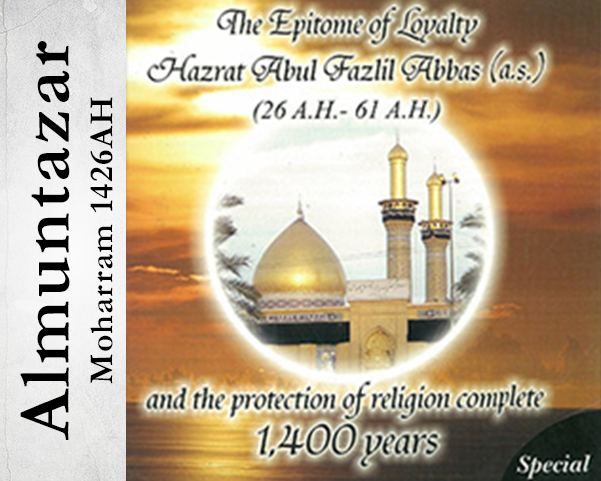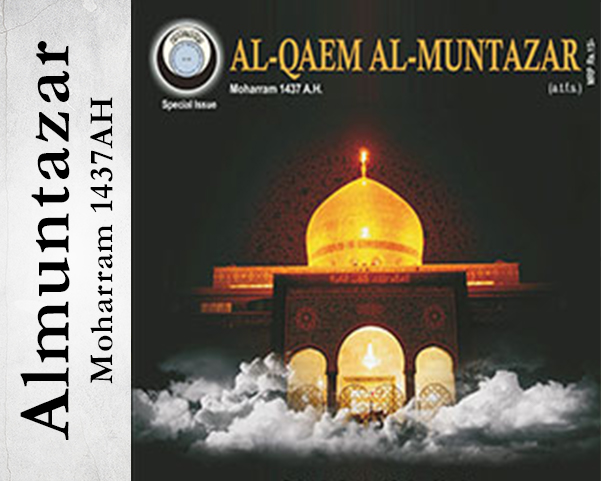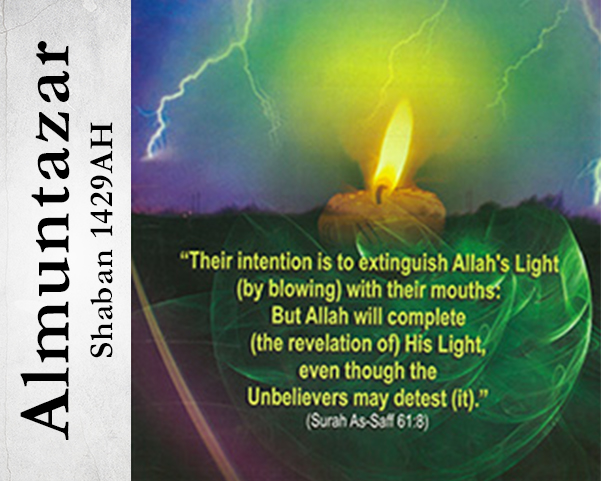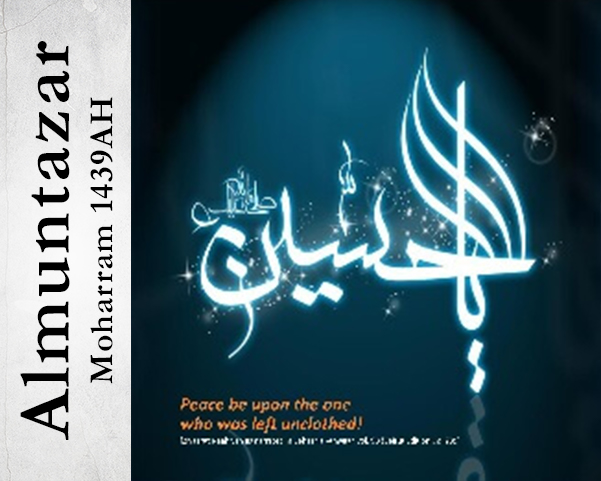Introduction
The belief of Raj’at is one of the hotly debated topics in Islam and religious scholars as well as Quranic commentators have put forth their views and opinions concerning it. They consider Raj’at to be an extension of the “theory of reincarnation” or the “theory of the cycle of human life”. They have pushed the limits of their intellect and have exhausted all their arguments and reasoning in order to justify and explain the belief of ‘Raj’at’.
After being submerged in the whirlpool of views and counter views, the belief in Imam Mahdi (a.s.) has emerged as a universal principle. It has soothed the heart of a distressed world and is proving to be a beacon for the survival of human race. It is proving to be the source of strength for facing insurmountable challenges and for making things possible. The honest and conscientious ones are inching towards this light.
The tranquil heart is bolstered with a new lease of life through the belief in Raj’at. This is because the proponents of this belief (of Raj’at) have convincing arguments along with manifest evidences. Clear indications in heavenly books as well the revered words, impeccable character and chaste actions of our infallible leaders (a.s.), have put a stamp of authenticity on this belief. Thus, it is possible for every impartial and unbiased individual to accept this belief.
Unfortunately, the majority amongst the Muslims chose to shun the radiant path of the Holy Quran and traditions (ahadith) and thus regarded Raj’at as impossible. Consequently, this divine grace (of belief in Raj’at) is found only amongst the followers of Imam Ali (a.s.) and it has been possible only due to the unstinting and relentless efforts of our great scholars of the past who have elucidated this belief and have presented it to us like precious pearls of the ocean.
With this intention we would, as a preamble, like the readers to acquaint themselves with those unique qualities of the Ahle Bayt (a.s.) that will enlighten us on the subject of Raj’at.
Preface
Before we get on with the actual discussion, we would like to present a few points as a prelude to our esteem readers. It should be borne in mind that the points in this preface are gleaned from authentic narrations.
• It is imperative and obligatory to accept whatever has been narrated by the infallible Imams (a.s.).
• It is mandatory to refer to the infallible Imams (a.s.) in all matters of jurisprudence
• Instead of rejecting ambiguous and apparently contradictory traditions, we should analyse them in the light of the Holy Quran.
• If two traditions appear to be contradictory, then we must accept the one upon which there is a consensus among a majority of the Shia scholars.
• We should refer to reliable Shia books of traditions whenever the need arises.
Lexical Meaning
Al-Jawhari in al-Sehaah and Raaghib Isfahaani in al-Qamoos have written the following statement concerning ‘Raj’at’. “So-and-so believes in Raj’at”. It means that “so-and-so” believes that he will return back to life in this world after his death. Hence, ‘Raj’at’ implies the returning back to life after death, but prior to the Day of Reckoning.
Raj’at – In the light of terminology and traditions (ahaadees)
In the light of the traditions of Ahle Bayt (a.s.), the Shia firmly believe that Allah the Exalted will bring back to life some people in the same form in which they had existed in the world. After their “return” (i.e. Raj’at), He will chastise some of them while He will honour and reward some others. He will let truth prevail over falsehood and extract justice and revenge for the ones who were oppressed, from their oppressors. All this will occur during the reign of Imam Mahdi (a.t.f.s.). But ‘Raj’at’ will be only for those who were either at the pinnacle of certitude (in Allah) or in the abyss of misguidance and deviation.
The Shias are distinct and unique in the belief of Raj’at. No scholar from Ahle Sunnah subscribes to this doctrine. The evidence we have concerning Raj’at is not from our side. Rather we only mention whatever the Holy Quran and Ahle Bayt (a.s.) have narrated to us. For, they (a.s.) are not deeply rooted in knowledge, but are also the (true) interpreters and teachers of the Holy Quran. Besides, they are the rightful inheritors of the knowledge of Holy Prophet (s.a.w.a.).
Proof on the Reality of Raj’at
There are numerous proofs on the reality of Raj’at. It has been unanimously and successively proved that the belief in Raj’at is included among “necessary beliefs of religion”. Here, we will enumerate each one of them.
(A) Raj’at – In the light of the Holy Quran
Numerous verses of the Holy Quran either directly prove the veracity of Raj’at, or point towards it through other verses or traditions.
1. Surah Baqarah, verse No 259
“Or the like of him who passed by a town, and it had fallen down upon its roofs; he said: When will Allah give it life after its death? So Allah caused him to die for a hundred years, then raised him to life. He said: How long have you tarried? He said: I have tarried a day, or a part of a day. Said He: Nay! you have tarried a hundred years; then look at your food and drink — years have not passed over it; and look at your donkey; and that We may make you a sign to men, and look at the bones, how We set them together, then clothed them with flesh; so when it became clear to him, he said: I know that Allah has power over all things.”
This verse categorically states that Allah gave death to this person for a hundred years and brought him back to life in this world. It’s apparent from the Holy Quran that the person was a Prophet and that is why Allah addressed him via revelations. Some traditions inform us that it was Prophet Irmiya (a.s.) while some suggests it was Hazrat Uzair (a.s.). What’s more, both — Shias and Sunnis — have acknowledged this tradition. Also it is mentioned in traditions, that whatever befell on the past nations will also occur for the nation of Holy Prophet (s.a.w.a.). Raj’at also is one of those things.
2. Surah Baqarah, verse 243
“Have you not considered those who went forth from their homes, for fear of death, and they were thousands, then Allah said to them, Die; again He gave them life; most surely Allah is Gracious to people, but most people are not grateful.”
This verse too underlines the fact that in a bygone era some people were brought back to life in this world after their death. Therefore, Raj’at is not a probability. Rather it is a reality that cannot be rejected and whatever has occurred in the previous nations will recur in the present nation (of Holy Prophet (s.a.w.a.)).
Keeping in view the eloquence of the Holy Quran, it can be said that this is the best proof on the authenticity of Raj’at. Moreover, it has come in traditions that their numbers (who were given life after death) was 70,000. By the command of Allah they remained dead for a long period of time after which they were brought back to life. And after returning to this world they continued living in it for a long time.
3. Surah Ghaafir, verse 51
“Surely We will help Our Messengers and those who believe, in the present life and upon the day when the witnesses arise.”
Innumerable traditions confirm that verse implies Raj’at and the apparent meaning of the verse too affirms these narrations. For, many Prophets, Imams and believers were not helped in this world while the verse declares that Allah will help them. Allah will never go against His promise.
However, this verse cannot be interpreted to justify the reappearance of Imam-e-Zamana (a.t.f.s). Because that would require us to detach ourselves from the context in which this verse was revealed and rely solely on the metaphorical meaning.
4. Surah Ghafir, verse 11
“They shall say, ‘Our Lord, Thou hast caused us to die twice and caused us to live twice; now we confess our sins. Is there a way to escape this?”
Numerous narrations have come in this regard that say that out of the two (death and life), one of them is associated to Raj’at. It is evident that the intention of this is not impossible. This does not imply there is a set limit concerning the second life or death. Being brought back to life from the grave cannot be considered as complete life by itself. Thus, it would be incorrect to say that two lives mean “life in the grave and coming back to life in the Hereafter and two deaths mean death in this world and death in the grave.”
Besides these, there are many verses of the Holy Quran that confirm Raj’at.
(B) Raj’at – In the light of traditions (ahaadees)
The traditions concerning Raj’at have been mentioned so frequently and consecutively that they have reached the level of “tawaatur” (continuity) and hence cannot be denied. However, one can find traditions concerning Raj’at under different subjects and topic. Some traditions speak about the Raj’at of the Messenger of Allah (s.a.w.a.) and the Infallible Imams (a.s.), while some mention about the return (Raj’at) of the Infallible Imams (a.s.). Some state that Raj’at will be there for the past Prophets (a.s.) while some talk about the Raj’at of some special group of Shias. Yet others speak about the return of those who were either at the pinnacle of faith or in the depths of deviation.
It should be borne in mind that wherever Raj’at has been discussed, it does not imply that only their qualities or their rule will return. Rather, they themselves will come back in person flesh, bones and spirit. Or else it will be absolutely wrong and contrary to the narrations concerning the reality of Raj’at. For, Raj’at is connected to the last era but noble characteristics and attributes are not specific to the last era only. In fact these qualities were always witnessed since the time of creation of Prophet Adam (a.s.). Every Prophet and his successor has been the heir of the traits and virtues of their predecessors and past Prophets. Rather even their companions, too, have been the bearers of the characteristics of their righteous forefathers.
We now analyze a few traditions concerning the different aspects of Raj’at.
1. The author of Majma’ al-Bayaan, Fadhl ibn Hasan al-Tabrisi under verse 83 of Surah Naml, ‘On the day We will bring forth a troop from every nation…’ writes:
‘There are many traditions from the infallible Imams (a.s.) that state that during the rising of Imam Mahdi (a.s.), Allah will bring back to life his (a.s.) followers who passed away earlier so that they’re rewarded with the status of being among his (a.s.) helpers. These Shias will be extremely thrilled to see the establishment of Imam’s (a.s.) government.
Similarly, some of his (a.s.) enemies too will be brought back to life in this world so that they are given a part of their quota of chastisement. Finally, after facing a lot of humiliation and disgrace in the world, they will be killed by the soldiers of Imam (a.s.).
(Al-Iqaaz, p. 250)
2. Sa’d Ibn Abdillah in Mukhtasar al-Basair while narrating from Bukair Ibn A’yon says, ‘The thing in which I don’t have an iota of doubt is the saying of Imam Baqir (a.s.) wherein he (a.s.) says, “There will be Raj’at for Holy Prophet (s.a.w.a.) and Ameerul Momineen (a.s.)”
(Al-Iqaaz, p. 379)
3. Ali Ibn Ibrahim narrates from Abu Baseer that Imam Sadiq (a.s.) said:
“Once Holy Prophet (s.a.w.a.) told Imam Ali (a.s.) that ‘In the last era, Allah will bring you back to life in the best of appearances while you will have an iron with which you will punish your enemies’.”
(Al-Iqaaz, p. 257)
4. Imam Sadiq (a.s.) while interpreting this verse:
“And remember the time when Allah took a covenant from all the Prophets that I have given you of book and wisdom; then there shall come to you a messenger confirming what is with you — you shall believe in him and help him…”
(Surah Aale Imran: Verse 81)
says:
“From the time of Hazrat Adam until now, Allah has not sent any Messenger except that he (a.s.) will come back in this world and assist the Holy Prophet (s.a.w.a.) and Ameerul Momineen (a.s.).”
(Al-Iqaaz, p. 332)
5. In Kitab-ul-Ghaibat, Shaikh Tusi (a.r.) narrates from Mufazzal ibn Umar:
‘We were in the holy presence of Imam Sadiq (a.s.) and were discussing about Imam Mahdi (a.t.f.s.) and about those who will depart from this world waiting for his reappearance. Imam (a.s.) said: “When he (a.s.) will rise, he will go at the graves of the believers and say, “O person, your Imam has appeared. If you so wish, come with your Imam or if you want, rest in the grace and enjoy the bounty of your Lord.”’
There are numerous reports that establish Raj’at not only as a correct and divine belief but also amongst the necessities of the Shia faith. The Shias are identified and recognized by this.
In this respect, Tabrisi in Ehtejaaj and Najaashi in his Rijaal have cited an interesting incident. Najaashi writes that Imam Sadi (a.s.) had a companion by the name of Momin-e-Taaq. He was renowned for his knowledge, piety and fame. Once Abu Hanifa asked him, “Do you believe in Raj’at?” He replied: “Of course”. Abu Hanifa said: “Then remove five hundred dinars from your pocket and give it to me as a loan. When I return to the world for the second time (in Raj’at), I will repay you back.” Promptly, Momin-e-Taaq replied, “For this you need to give me a guarantee that you’ll return like a human. I fear that you may return in some other form and I will be unable to recover my money.”
Mention of Raj’at in supplications and ziyaaraat
If the important actions and supplications are to be closely studied, one will find Raj’at mentioned in most of them. Furthermore, there is an emphasis in all of them to have a firm belief in it.
1. In the supplications for the month of Rajab, Shaikh Tusi (a.r.) narrates in his book Misbaah from Husain Ibn Rauh (a.r.): “In whichever place of ziyarat you are present, say this ‘…salutations, peace and Allah’s blessings be upon you till the time I reach in your service again during your Raj’at and when I am included in your army.’
2. Ziyaarat of Imam Husain (a.s.): Shaikh Kulayni (a.r.) narrates under the chapter of Ziyaarat of Imam Husain (a.s.) that Imam Sadiq (a.s.) says:
“And when you are at the grave of Imam Husain (a.s.) then say:
“I bear witness that I keep faith in you and I firmly believe in your Raj’at.”
Ibn Qulwayh (a.r.), too, has chronicled this tradition in his book Mazaar.
3. Ziyaarat-e-Jaameah: Shaikh Sadooq (a.r.) in his books Man la yahdhuruhu al-faqih and Uyoon-o-Akhbar al Reza (a.s.); Shaikh Tusi (a.r.) in Tehzeeb have narrated from reliable sources that Imam Ali an-Naqi (a.s.) says in Ziyaarat-e-Jaameah:
“I acknowledge your status and position, I am certain of your Raj’at and I confirm your promised return. I am spending my life waiting for your reign and government….. May Allah include me among those who will be reckoned as your adherents and who will govern in your reign.”
4. Recommended Acts of Worship for Friday:
Shaikh Tusi (a.r.) has written in Misbaah:
Imam Ja’far as-Sadiq (a.s.) says:
The one who wants to do ziyaarat of Holy Prophet (s.a.w.a.), Ameerul Momineen (a.s.) and Janabe Zahra (s.a.) or anyone of us, he should perform ghusl and say…
I am with all of you and not with your enemies. I submit to your excellence and accept your Raj’at — I don’t deny the power of Allah.
Objections concerning Raj’at
Without understanding the meaning and essence of the traditions of Ahle Bayt (a.s.), the denier of Raj’at have either rejected it outright or have compelled themselves to analyze and rationalize the traditions, notwithstanding the unanimity and firm belief of the infallible Imams (a.s.) and the Shia scholars concerning Raj’at.
Following are the answers to the few objections raised by the antagonist of Raj’at.
1. In his book Fajr al-Islam, Ahmed Ameen writes that due to their belief in Raj’at, the school of Shiasim resembles Judaism
Answer: If believing in Raj’at makes the Shia religion similar to Judaism, then the Holy Quran itself reflects Judaism ideology. For, in the earlier part of this article, we have mentioned not one but four verses of Quran (among the many) that vouch for the veracity of Raj’at…
According to the aforementioned author, a lot of Islamic laws and beliefs bear resemblance to those in Judaism and Christianity since the Holy Prophet (s.a.w.a.) has endorsed many laws from those divine religions. Thus, it is obvious that certain Islamic beliefs will mirror tenets of Judaism and Christianity. But if the Holy Prophet (s.a.w.a.) has not found any fault or defect in them, then what authority does a follower of Islam have to raise his own opinion contrary to that of the Holy Prophet (s.a.w.a.)?
2. Raj’at is impossible
The reason given by the deniers for eschewing Raj’at is that they feel Raj’at is impossible and unlikely because such things are difficult to comprehend for the weak minds.
Replies:
a) To consider something as impossible and unlikely isn’t a valid or logical argument and cannot be compared to the real proof
b) Raj’at isn’t impractical. Rather, it is possible because in the light of the Holy Quran it has occurred earlier and the biggest proof of something being possible is its occurrence.
c) Such things are of no significance in the presence of the favours and kindness of Ahle Bayt (a.s.) and in front of the Infinite power of Allah the belief in Raj’at is absolutely correct. In his book Fazaailul Aimmah (a.s.), Hafiz Rajab Borsi has reported amazing traditions concerning the superiority of Ahle Bait (a.s.).
He writes: A person who had a heart ailment rejected this tradition (about Raj’at). I said, ‘Do you deny the power and bounties of Allah or do you reject the Infallible Imam (a.s.)? If you deny the power of Allah, then consider the huge fish in the time of Prophet Sulayman (a.s.). It swallowed the entire food that was kept on the tablecloth at one go while that food was for an entire month. Then it said, ‘This? This is just a small portion of our daily share.’ A dazed Hazrat Suleiman (a.s.) asked: ‘Are there any more fishes like you in the ocean?’The fish replied: ‘There are thousands like us.’
Sulayman (a.s.) exclaimed, ‘Allah is a Marvelous King. He is Pure from all kinds of defects He creates things which none is aware of.’
2. The traditions on Raj’at are not found in reliable books. Besides, their numbers are not enough for one to have absolute faith in them.
Reply: Traditions on Raj’at can be found extensively in the books of reliable authors. Rather, they have attained consecutiveness (tawaatur). Allama Tabatabai (r.a.) has written in his famous exegesis of the Holy Quran, Al-Mizan Fi Tafseer al-Quran that traditions concerning Raj’at have been mentioned consecutively by the Ahle Bayt (a.s.)
In al-Iqaaz, the celebrated and great scholar Shaikh Hurr al-Aameli (r.a.) has enumerated a long list of scholars along with the names of their books who have written about Raj’at. Allama Majlisi (r.a.) writes: “If this isn’t consecutiveness (tawaatur), then what is?
Therefore, we can easily conclude that the reports found on Raj’at are absolutely irrefutable and unassailable.
(References: Al-Iqaaz minal Hujjat bil Burhan Alal Raj’at by Shaikh Hurr Aameli (a.r.), Aayatul Ma’aref alal hayaat, Behar al-Anwaar, vol. 53)















